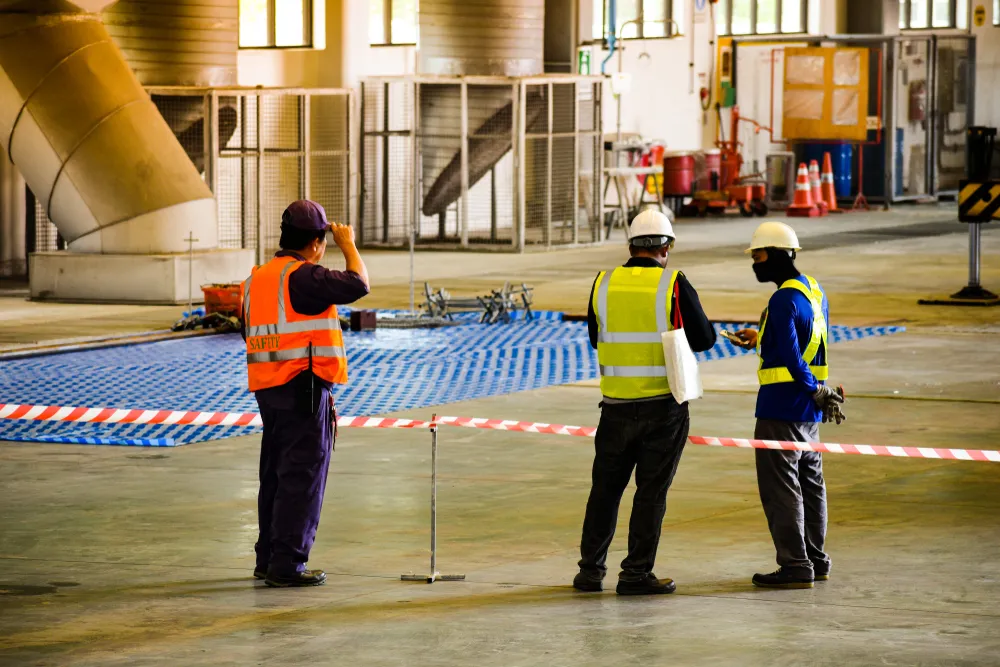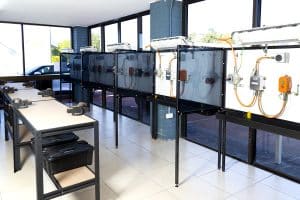Roar Solutions - Truths
Roar Solutions - Truths
Blog Article
The Of Roar Solutions
Table of ContentsThe Best Strategy To Use For Roar SolutionsSome Known Factual Statements About Roar Solutions Roar Solutions for Dummies
In such an ambience a fire or surge is possible when three basic conditions are met. This is typically described as the "dangerous location" or "burning" triangular. In order to shield installations from a prospective explosion a method of analysing and identifying a potentially harmful location is required. The function of this is to make sure the appropriate choice and installment of tools to ultimately protect against a surge and to make certain safety and security of life.
(http://www.place123.net/place/roar-solutions-mackay-harbour-qld-australia)
No devices should be set up where the surface temperature of the devices is above the ignition temperature level of the provided danger. Below are some usual dust hazardous and their minimum ignition temperature. Coal Dirt 380C 225C Polythene 420C (thaws) Methyl Cellulose 420C 320C Starch 460C 435C Flour 490C 340C Sugar 490C 460C Grain Dust 510C 300C Phenolic Material 530C > 450C Aluminium 590C > 450C PVC 700C > 450C Soot 810C 570C The probability of the threat being present in a concentration high sufficient to create an ignition will certainly vary from place to area.
In order to categorize this threat a setup is split into areas of threat depending upon the quantity of time the unsafe exists. These areas are described as Areas. For gases and vapours and dusts and fibres there are three areas. Zone 0 Area 20 An unsafe atmosphere is extremely most likely to be present and may exist for extended periods of time (> 1000 hours each year) and even continually Area 1 Area 21 A harmful environment is possible however unlikely to be existing for extended periods of time (> 10 450 C [842 F] A category of T6 suggests the minimal ignition temperature is > 85 C [185 F] Harmful location electric tools possibly developed for usage in greater ambient temperatures. This would suggested on the ranking plate e.g. EExe II C T3 Ta + 60C( This means at 60C ambient T3 will not be exceeded) T1 T1, T2, T3, T4, T5, T6 T2 T2, T3, T4, T5, T6 T3 T3, T4, T5, T6 T4 T4, T5, T6 T5 T5, T6 T6 T6 A T Class rating of T1 indicates the maximum surface temperature generated by the instrument at 40 C is 450 C. Presuming the associated T Course and Temperature level rating for the equipment are suitable for the location, you can always make use of an instrument with a more rigorous Department rating than needed for the location. There isn't a clear response to this question. It really does depend upon the kind of equipment and what repair work require to be brought out. Equipment with specific test treatments that can't be done in the field in order to achieve/maintain third event score. Need to come back to the manufacturing facility if it is prior to the devices's solution. Field Repair Work By Authorised Employee: Complex screening might not be required nevertheless particular treatments might need to be adhered to in order for the devices to keep its 3rd event ranking. Authorised workers need to be employed to execute the work appropriately Repair service should be a like for like replacement. New part have to be taken into consideration as a direct replacement needing no unique testing of the tools after the fixing is complete. Each tool with a dangerous score ought to be examined individually. These are detailed at a high level listed below, but for more comprehensive details, please refer directly to the guidelines.
Excitement About Roar Solutions
The tools register is a detailed database of tools documents that consists of a minimum collection of fields to identify each item's area, technological specifications, Ex lover category, age, and environmental data. This details is important for monitoring and taking care of the tools effectively within harmful locations. In contrast, for routine or RBI tasting examinations, the grade will certainly be a combination of Thorough and Close assessments. The ratio of Comprehensive to Close inspections will certainly be figured out by the Equipment Threat, which is evaluated based upon ignition danger (the chance of a resource of ignition versus the likelihood of a combustible atmosphere )and the dangerous area category
( Zone 0, 1, or 2). This variant will additionally affect the resourcing requirements for job prep work. As soon as Whole lots are specified, you can develop tasting plans based upon the example size of each Great deal, which describes the variety of arbitrary tools items to be inspected. To determine the needed sample size, two facets require to be reviewed: the dimension of the Great deal and the classification of examination, which suggests the level of initiative that should be applied( reduced, normal, or enhanced )to the assessment of the Lot. By integrating the classification of assessment with the Great deal size, you can then establish the proper rejection requirements for an example, indicating the allowable variety of damaged items discovered within that example. For more information on this procedure, please refer to the Power Institute Guidelines. The IEC 60079 conventional advises that the maximum period between assessments must not surpass 3 years. EEHA inspections will certainly also be carried out outside of RBI campaigns click here now as part of scheduled upkeep and equipment overhauls or repairs. These evaluations can be credited toward the RBI sample dimensions within the affected Lots. EEHA inspections are performed to recognize faults in electrical devices. A heavy scoring system is important, as a solitary piece of devices may have numerous mistakes, each with differing levels of ignition danger. If the mixed score of both assessments is less than two times the fault rating, the Whole lot is deemed appropriate. If the Whole lot is still considered undesirable, it should undertake a complete assessment or justification, which may trigger stricter assessment methods. Accepted Lot: The root causes of any faults are determined. If a common failing setting is found, additional equipment might require examination and repair work. Mistakes are classified by seriousness( Security, Stability, Housekeeping ), making sure that urgent issues are examined and attended to without delay to alleviate any kind of effect on security or procedures. The EEHA database should track and videotape the lifecycle of faults together with the corrective actions taken. Executing a robust Risk-Based Examination( RBI )strategy is important for guaranteeing conformity and security in managing Electrical Tools in Hazardous Areas( EEHA) (eeha certificate). Automated Fault Scoring and Lifecycle Administration: Easily manage mistakes and track their lifecycle to enhance inspection precision. The introduction of this assistance for risk-based examination further reinforces Inspectivity's position as a best-in-class service for regulatory conformity, along with for any type of asset-centric assessment use instance. If you are interested in finding out more, we invite you to ask for a demonstration and find exactly how our remedy can change your EEHA management procedures.
How Roar Solutions can Save You Time, Stress, and Money.

In regards to explosive danger, a harmful location is a setting in which an eruptive environment is existing (or may be anticipated to be existing) in amounts that require unique safety measures for the building and construction, installation and usage of equipment. hazardous area electrical course. In this write-up we explore the difficulties encountered in the office, the danger control steps, and the called for proficiencies to work securely
It is a consequence of contemporary life that we manufacture, keep or take care of a variety of gases or liquids that are regarded combustible, and a variety of dusts that are deemed flammable. These materials can, in specific conditions, develop explosive ambiences and these can have major and awful consequences. Most of us recognize with the fire triangle eliminate any kind of one of the 3 elements and the fire can not take place, but what does this mean in the context of dangerous locations? When breaking this down into its easiest terms it is essentially: a combination of a particular quantity of release or leakage of a particular material or product, combining with ambient oxygen, and the presence of a source of ignition.
In the majority of circumstances, we can do little concerning the levels of oxygen airborne, but we can have considerable impact on resources of ignition, for instance electrical tools. Dangerous areas are recorded on the unsafe location classification drawing and are recognized on-site by the triangular "EX" sign. Below, among various other key info, zones are split into three types depending upon the risk, the likelihood and period that an eruptive atmosphere will certainly exist; Area 0 or 20 is considered the most harmful and Zone 2 or 22 is considered the least.
Report this page